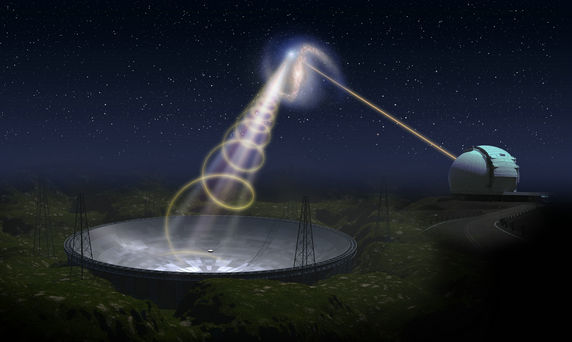FAST Reveals Dynamically Evolving Environment Around a Repeating Fast Radio Burst Source

Image: Artist’s Illustration of FAST and Keck observation. (Credit: Jingchuan Yu and Hai Fu.)
Fast radio bursts (FRBs) are highly dispersed millisecond-duration radio bursts. They are extremely powerful - comparable to the amount of energy modern human civilization could produce over tens of billions of years. Since the discovery of the first FRB in 2007, several hundred of them had been found. However, the physical origin of FRBs is still unsettled.
Most of these FRBs come from outside of the Milky Way. Recent observations of an FRB originating from a Galactic magnetar (a type of neutron star believed to have an extremely strong magnetic field) suggest that some FRBs come from magnetars, but the origin of the cosmological FRBs, especially those that actively repeat, has been unclear.
Using the Five-hundred-meter Aperture Spherical radio Telescope (FAST), a research team from the National Astronomical Observatories of the Chinese Academy of Sciences (NAOC) has detected nearly 2,000 radio bursts from FRB 20201124A. The team's research strongly indicates that FRB 2021124A is embedded in a complicated, dynamically evolving magnetized environment.
The study was published in Nature on Sept. 21. It may help us understand how these radio bursts were generated and how the radio burst signal propagated in the local magnetized environment.
The researchers used FAST to monitor FRB 20201124A for about two months. They analyzed 1,863 bursts of FRB 20201124A detected by FAST during a total of 84hours of observation over 54 days, which is the largest sample of bursts recorded with polarization information so far. The high event rate makes FRB 20201124A among the most active known FRBs.
They discovered several phenomena never detected before, e.g., the irregular short-time variation of the Faraday rotation measure, which probes the line-of-sight magnetic field strength, of individual bursts during the first 36 days, followed by a constant value; the quenching of the burst activity on a timescale shorter than three days; prominent circular polarization in these bursts (up to 75%); and oscillations in fractional linear and circular polarizations as well as polarization angle as a function of wavelength.
All these features provide strong evidence for a complicated, dynamically evolving magnetized environment within about one astronomical unit of this FRB source. Based on the oscillation structures in polarizations, they set a constraint on the magnetic field of this magnetized local environment, which reaches gauss level.
Observations with the Keck 10-m optical telescope have revealed that FRB 20201124A resides in a low-density interim region of a Milky Way-like galaxy. This environment is inconsistent with a young magnetar engine formed during an extreme explosion of a massive star resulting in a long gamma-ray burst or superluminous supernova.
"This is like taking a movie of the surroundings of an FRB source," said ZHANG Bing, a corresponding author of the study, "and our film reveals a complex, dynamically evolving, magnetized environment that was never imagined before."
Since such an environment is not expected for an isolated magnetar, ZHANG said that "something else might be in the vicinity of the FRB engine, possibly a binary companion."
"This is the largest sample of FRB data with polarization information from one single source," said ZHU Weiwei from NAOC, also a corresponding author of the study.
"This location is inconsistent with a young magnetar central engine formed during an extreme explosion such as a long gamma-ray burst or a superluminous supernova, widely speculated progenitors of active FRB engines," said co-corresponding author DONG Subo from Peking University.
This study can be accessed at https://www.nature.com/articles/s41586-022-05071-8